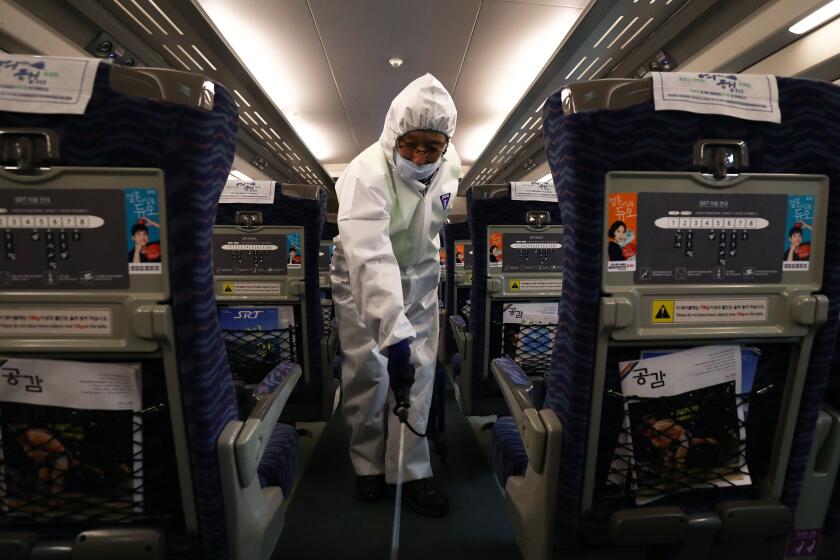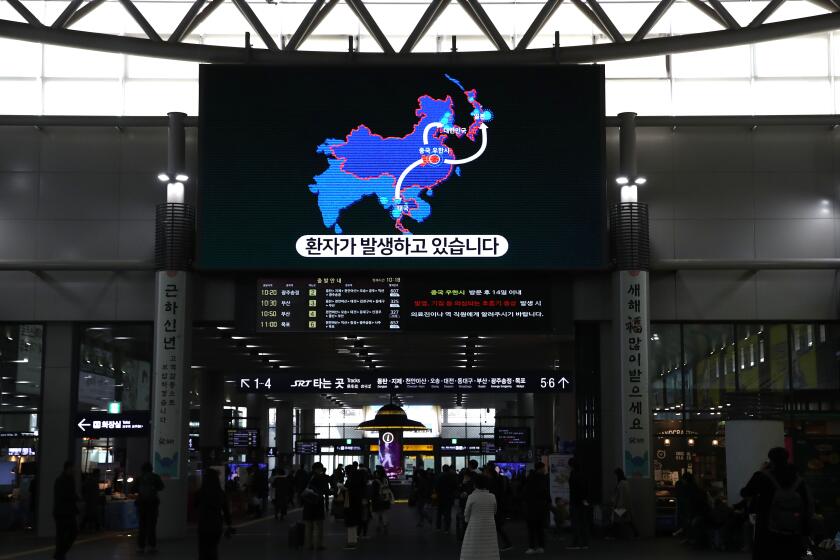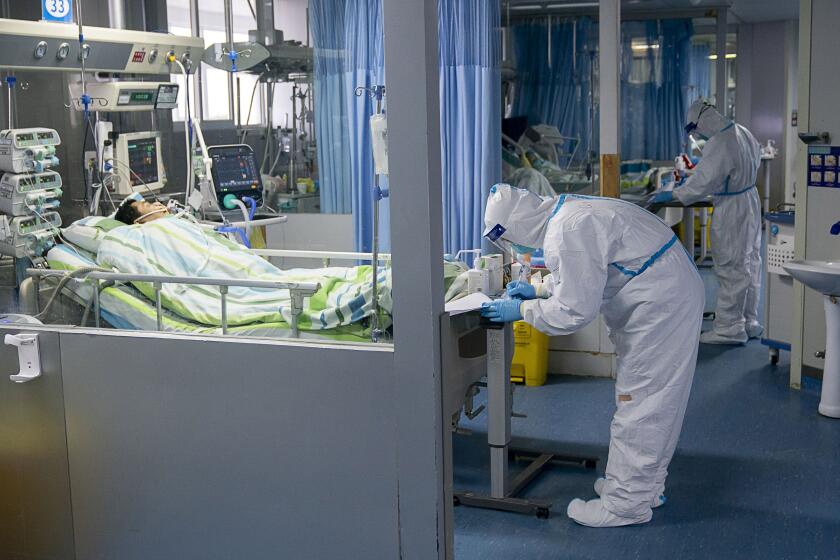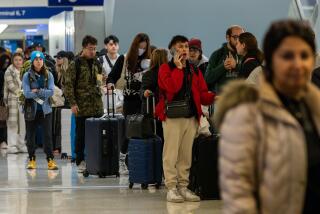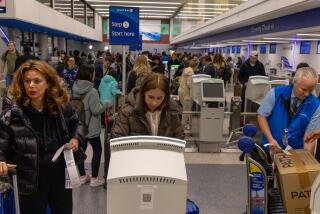California’s first two cases of coronavirus are confirmed in L.A. and Orange counties

- Share via
Health officials have confirmed the first two cases of the new strain of coronavirus in Los Angeles and Orange counties, brought by travelers who came from the epicenter of the outbreak in Wuhan, China.
In both counties, the virus infecting the two individuals was the same strain as the one that has spread to more than 2,700 people in 14 countries and territories and caused 80 deaths since it was discovered late last month in central China. Three other cases have been diagnosed in the U.S., one each in Arizona, Washington state and Chicago.
Governments and health officials around the world are trying to mitigate the spread of the coronavirus outbreak.
In L.A. County, the infected person was a returning traveler from Wuhan who is receiving medical treatment at a hospital, officials said.
The Orange County patient is in good condition and is in isolation at a hospital, health officials said. In both counties, health authorities are following up with anyone who has had close contact with the patients, but they noted that casual contact with an infected person — such as visiting the same grocery store or movie theater — carries only “minimal risk of developing infection.”
“The risk of local transmission remains low,” officials said.
The L.A. County patient is a Wuhan resident who was flying through Los Angeles International Airport on Wednesday on his way back to China, L.A. County public health officials said during a news conference Sunday.
“The infected person presented themselves immediately for care at LAX airport once they noticed they weren’t feeling well,” said L.A. County public health director Dr. Barbara Ferrer. The patient was taken from LAX directly to a hospital, and no L.A. County residents were infected or at risk as of Sunday morning, Ferrer said.
The Arizona case, which was also announced Sunday, was a Maricopa County resident who health officials described as “a member of the Arizona State University community” but who did not live in university housing. The patient had recently returned from a trip to Wuhan, health officials said.
The patient was not severely ill and was being kept in isolation, the Arizona Department of Health Services and Maricopa County Department of Public Health said. Officials were working to identify and reach out to people who might have been exposed to the virus while the patient was contagious, officials said.
Any time a “novel” virus appears on the scene, things immediately become much more complicated. That’s certainly the case with the coronavirus from China.
The new strain of coronavirus, known as 2019-nCoV, can cause respiratory illness and pneumonia. It was originally thought to be spreading only from animals to people in central China, but there are now indications it is also spreading among people.
The virus can cause pneumonia-like symptoms, including fever, coughing and shortness of breath and, in extreme cases, can be fatal.
Most of the dead were at least 50 years old with underlying medical problems or weakened immune systems, Chinese officials said. But a 36-year-old man succumbed to the coronavirus last week, and a healthcare worker also was reported to be among the fatalities.
If the coronavirus outbreak in China were a Hollywood movie, now would be time to panic. But in real life, most Americans have no need, experts say.
Health experts in the United States have said there’s no evidence to suggest the new coronavirus is any more virulent than the flu.
But because this strain of coronavirus is new, health officials are on high alert, and researchers will have to start from square one in creating a vaccine, which will probably take years to develop.
Coronaviruses include a large variety of viruses — the common cold as well as those that caused Severe Acute Respiratory Syndrome (SARS) and Middle East Respiratory Syndrome (MERS). SARS and MERS sickened thousands of people around the world and caused hundreds of deaths.
It is too soon to tell how the new strain compares to coronaviruses that fueled the previous epidemics, experts said.
“I think that there are important unanswered questions about this outbreak,” said Anne W. Rimoin, an epidemiologist at the UCLA Fielding School of Public Health and director of the UCLA Center for Global and Immigrant Health. “We don’t know how easily people transmit the virus or how ill it can make otherwise healthy people. We just don’t know the true risks posed by this new virus, and these are the questions that will need to be answered.”
Cities from central China to Hong Kong are scrambling to stop the spread of an illness that has infected more than 2,000 people and killed at least 56.
As of Friday, 18 people between the ages of 3 and 58 had been tested for the virus in California, according to the state Department of Public Health. They included a traveler who arrived at Los Angeles International Airport on a flight from Mexico City and was taken to a hospital early Thursday for an evaluation.
L.A. County public health officials could not confirm whether the Mexico City traveler was the same one with the virus.
“We’re working very closely with LAX, we have staff stationed at the quarantine station,” said Dr. Sharon Balter, director of the L.A. County Public Health Department’s Acute Communicable Disease Control program. “All travelers who are arriving from China are being screened…. [LAX officials] call us immediately if they think anybody needs to be tested and then they work with our staff … to get them to a hospital that’s appropriate to test them, and everything went as one would expect in this case.”
Dr. Sonia Angell, director of the California Department of Public Health, said in a statement Sunday that the immediate health risk to the general public in California is low, but “the California Department of Public Health has been preparing for this situation by working closely with local health departments and health care providers.”
Healthcare workers who treat anyone with this kind of infectious disease should make sure they wash their hands after contact and consider wearing protective eye gear, officials said.
At Orange County Global Medical Center and Regional Trauma Center, patients who come in with respiratory symptoms are given masks, and an infectious disease specialist regularly consults with the staff to provide education about what to look for when performing triage, said Dr. Vu Huynh, medical director of emergency services.
If a patient is suspected to be infected with coronavirus, staffers have been instructed to quarantine them in an isolated room and contact the Centers for Disease Control and Prevention so a special series of tests can be performed, Huynh said. So far, the hospital has had one patient tested, and the results came back negative, he said.
Still, the staff is prepared to see more cases of the virus.
“There could have been a lot of cases that weren’t caught at the beginning, and maybe those patients traveled,” Huynh said. “With Southern California being a multicultural area, I think there’s more risk.”
Though the U.S. has not seen a major outbreak, the virus has spread widely across Asia in the last month.
If the coronavirus outbreak in China were a Hollywood movie, now would be time to panic. But in real life, most Americans have no need, experts say.
China’s health minister said the country was entering a “crucial stage” as “it seems like the ability of the virus to spread is getting stronger.”
As the spread of the virus continued to accelerate and fears intensified, two of Hong Kong’s biggest attractions, Hong Kong Disneyland and Ocean Park, announced they were closing for the time being.
The Asian Football Confederation said it was moving an Olympic qualifying event scheduled to start Feb. 3 from Nanjing to Sydney, Australia, and the International Tennis Federation moved a regional Fed Cup qualifying event from Dongguan to Kazakhstan next month.
Beijing said it would delay the start of classes for all schools, from kindergarten to universities, until after the Lunar New Year holiday ends this week.
In the Hong Kong suburb of Fanling, protesters set fire to the lobby of a building in an unoccupied public housing complex where officials had proposed quarantining suspected coronavirus cases. The fire was extinguished, and no major damage was reported.
Also on Sunday, Chinese authorities announced a temporary ban on the trade of wild animals and warned the public against eating wild animal meat. No wildlife can be transported or sold in any markets or online, according to text of the announcement in state media, and officials said they will “severely investigate and punish” violators.
The pneumonia-like illnesses from the newly identified coronavirus first appeared last month in Wuhan, where most of the early victims said they had visited a large seafood and live animal market. Other cases have been reported in Japan, South Korea and Thailand. Singapore, Vietnam and Hong Kong reported their first cases Thursday.
The U.S. State Department announced Sunday morning that it will relocate personnel at the U.S. Consulate General in Wuhan to the U.S. via a single flight Tuesday from Wuhan to San Francisco. There is limited space for private American citizens on the flight, officials said. “Capacity is extremely limited; priority will be given to individuals at greater risk from coronavirus,” the State Department said in a news statement.
Canada reported its first case Saturday in Toronto. Officials said the man is in his 50s and recently flew from Wuhan to Guangzhou, China, and then on to Toronto on Thursday.
The first coronavirus cases in Europe have also been confirmed, with three patients being treated in French hospitals. All three had recently traveled to China; they were reportedly doing well, according to officials.
The CDC is screening passengers on direct and connecting flights from Wuhan at five major airports in Atlanta, Chicago, New York, San Francisco and Los Angeles.
Experts say that the U.S. is well equipped to deal with any possible outbreak and that it’s important to remain calm.
“Fear spreads a lot faster than the virus itself,” Rimoin said. “We need to make sure that people do not have undue worry. We have a good public health system in place, and we’ve been preparing for this.”
Times staff writers Emily Baumgaertner in Los Angeles and Cindy Chang in Beijing, contributed to this report. The Associated Press was used in compiling this report.
More to Read
Sign up for Essential California
The most important California stories and recommendations in your inbox every morning.
You may occasionally receive promotional content from the Los Angeles Times.
